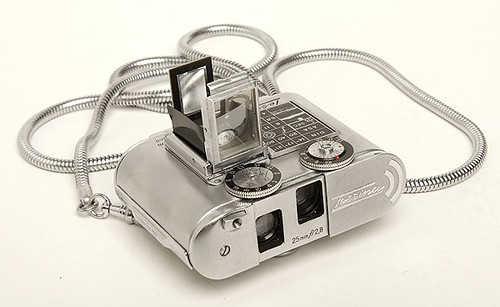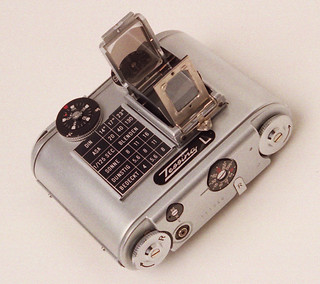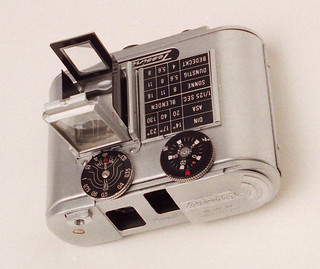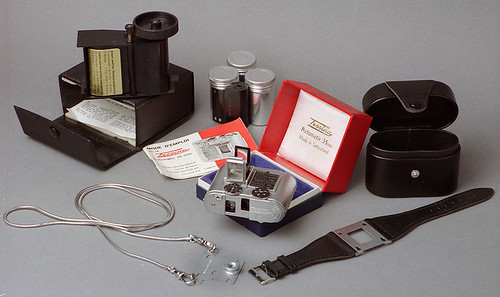Difference between revisions of "Tessina"
m (typo) |
Hanskerensky (talk | contribs) (Added Category year of introduction) |
||
| (25 intermediate revisions by 7 users not shown) | |||
| Line 1: | Line 1: | ||
| − | {{ | + | <div class="floatright plainlinks" style="margin:0px 0px 10px 15px;"> |
| − | + | {{Flickr_image | |
| + | |image_source= http://www.flickr.com/photos/ricksoloway/2947370294/in/pool-camerawiki | ||
| + | |image= http://farm4.static.flickr.com/3246/2947370294_f5e05177e8.jpg | ||
| + | |image_align= | ||
| + | |image_text= Tessina 35 | ||
| + | |image_by=Rick Soloway | ||
| + | |image_rights=wp | ||
| + | }} | ||
| + | </div> | ||
| + | '''Tessina''' cameras are a range of [[subminiature]] cameras made in Switzerland by Sigrist, and distributed by Concava S. A, from c.1960 for around four decades<ref>{{McKeown12}} Page 210. [http://en.wikipedia.org/wiki/Tessina Wikipedia] quotes a date range of 1957-96, but this is unreferenced.</ref>. It has three unusual features for a subminiature camera: it is a true [[TLR|twin-lens reflex]]; it uses [[35mm film]], in special cassettes, running across the bottom of the camera - at a right-angle to the lens axis; and it has spring motor film advance. There are three very similar models, the '''Tessina 35''', the '''Tessina Automatic 35''' and the '''Tessina L'''. | ||
| − | + | The image size is 14×21mm - smaller than a standard half-frame camera, but larger than many subminiatures. A daylight loader was available to load the cassettes with 14-20 inches of standard 35mm film, giving between 20 and 30 exposures per cassette.<ref name=W2>[https://www.leitz-auction.com/en/Concava-Tessina-Rot-Ausruestung/AI-17-11520 1963 Tessina 35 Automatic in red finish], with the prism finder, tripod plate, daylight film loader and other accessories, sold at the [https://www.leitz-auction.com/en/Cameras/Past-Auctions/Auction-17/ seventeenth Westlicht Photographica Auction], in May 2010.</ref><ref name=Man>[http://www.butkus.org/chinon/tessina_auto_35/tessina_auto_35.htm User's manual for the Tessina Automatic 35] at [http://www.butkus.org/chinon/ Orphan Cameras].</ref> | |
| + | |||
| + | The camera body is metal, with rounded ends, and measures 69×56×27mm (2½×2¼×1 inch). The camera has a coated Tessinon 25mm f/2.8 lens, and a flash-synchronised shutter with speeds 1/2-1/500 second, plus 'B'. The lenses have a sliding cover for protection. | ||
| + | |||
| + | On the top is the ground-glass focusing screen, with a mounting for interchangeable viewfinders. The standard finder is a folding eye-level [[Viewfinder#Albada finders|Albada finder]] which also acts as a hood for waist-level focusing using the ground glass. A vertical magnifying finder,<ref name=W3>[https://www.leitz-auction.com/en/Concava-Tessina-Black/AI-9-27004 Tessina 35] with the prism and magnifying finders, sold at the [https://www.leitz-auction.com/en/Cameras/Past-Auctions/Auction-9/ ninth Westlicht auction], in May 2006.</ref> and a prism finder were available as alternatives; these both have dioptric correction (for the user's eyesight).<ref name=Man/><ref name=W1>[https://www.leitz-auction.com/en/Concava-Tessina-35/AI-20-13177 Tessina 35] with the prism finder and shoe-mounting lightmeter, sold at the [https://www.leitz-auction.com/en/Cameras/Past-Auctions/Auction-20/ 20th Westlicht auction], in November 2011.</ref> | ||
| + | |||
| + | Also on the top are the focus and aperture dials. The aperture dial has the frame counter fitted on top, while there is a depth-of-field indicator on the focus dial. There is also an accessory shoe, which normally holds an exposure table. An accessory lightmeter exists, which mounts in place of this table.<ref name=W1/> | ||
| + | |||
| + | The shutter speed is set on a dial at the back. The shutter release button is on the front, and is threaded for a cable release. | ||
| + | |||
| + | The camera has automatic clockwork film advance: the advance mechanism can be wound in advance for 5-8 exposures.<ref name=Man/> The winding knob is on the back, as is the rewind knob, rewind release, and the [[PC socket]]. | ||
| + | |||
| + | The bottom of the camera has several studs to hold a tripod adapter plate, to avoid making room for a tripod bush in the body.<ref name=W2/> The camera can also be mounted on a leather wrist-strap. | ||
| + | |||
| + | Because a mirror is used to direct the image to the film, the negatives are reversed left-right relative to those from a normal camera; this is corrected during printing (by mounting the negative upside-down in the enlarger). | ||
| + | |||
| + | |||
| + | {{Flickr_image | ||
| + | |image_source= http://www.flickr.com/photos/90900361@N08/8717384474/in/pool-camerawiki | ||
| + | |image= http://farm8.staticflickr.com/7340/8717384474_1ffe8f9ccf_n.jpg | ||
| + | |image_align= left | ||
| + | |image_text= Tessina L | ||
| + | |image_by= Geoff Harrisson | ||
| + | |image_rights= wp | ||
| + | }} | ||
| + | {{Flickr_image | ||
| + | |image_source= http://www.flickr.com/photos/90900361@N08/8716263755/in/pool-camerawiki | ||
| + | |image= http://farm8.staticflickr.com/7401/8716263755_98456db2c6_n.jpg | ||
| + | |image_align= left | ||
| + | |image_text= Tessina L | ||
| + | |image_by= Geoff Harrisson | ||
| + | |image_rights= wp | ||
| + | }} | ||
| + | {{Flickr_image | ||
| + | |image_source= http://www.flickr.com/photos/90900361@N08/8717384176/in/pool-camerawiki | ||
| + | |image= http://farm8.staticflickr.com/7334/8717384176_3046430b26.jpg | ||
| + | |image_align= left | ||
| + | |image_text= Tessina Automatic 35 with accessories: <br>film loader, cassettes, case, neck chain on tripod adaptor, wrist strap. | ||
| + | |image_by= Geoff Harrisson | ||
| + | |image_rights= wp | ||
| + | }} | ||
| + | {{br}} | ||
| + | ==Notes== | ||
| + | {{Flickr_image | ||
| + | |image_source= https://www.flickr.com/photos/90900361@N08/51388223586/in/pool-camerawiki | ||
| + | |image= https://live.staticflickr.com/65535/51388223586_f85aaab057_n.jpg | ||
| + | |image_align= right | ||
| + | |image_text= Tessina in black finish <br><small>image by Sean Powers</small> | ||
| + | |image_by= | ||
| + | |image_rights= wp | ||
| + | }} | ||
| + | <references /> | ||
==Links== | ==Links== | ||
| − | |||
* [http://www.cameraquest.com/tessina.htm Tessina on Cameraquest] | * [http://www.cameraquest.com/tessina.htm Tessina on Cameraquest] | ||
* [http://www.submin.com/35mm/collection/tessina/introduction.htm Tessina on Submin.com] | * [http://www.submin.com/35mm/collection/tessina/introduction.htm Tessina on Submin.com] | ||
| + | * [https://www.butkus.org/chinon/tessina_auto_35/tessina_auto_35.htm Tessina Auto 35 / Auto reflex instruction manual (PDF - Eng. & German)] from OrphanCameras [https://www.butkus.org/chinon/index.html] | ||
| + | * [https://worldwide.espacenet.com/patent/search?q=pn%3DAT246552B Austrian Patent 246552] of 1966, ''Spiegelreflexkamera'' granted to Dr Ing. Rudolf Steineck seems to refer to the Tessina, though it describes a model which has not been seen, having a built-in selenium meter, with the cell on the front face of the camera; at [http://worldwide.espacenet.com/ Espacenet], the patent search facility of the European Patent Office. Text in German. | ||
| + | * [https://www.leitz-auction.com/en/Concava-Tessina-35-Gold-outfit/AI-4-22344 Tessina 35 in gold finish], with accessories, sold at the [https://www.leitz-auction.com/en/Cameras/Past-Auctions/Auction-4/ fourth Westlicht auction], in November 2003. | ||
| + | * [https://www.leitz-auction.com/en/Concava-Tessina-L-chrome-outfit/AI-14-17681 Tessina L] with lightmeter and film loader, sold at the [https://www.leitz-auction.com/en/Cameras/Past-Auctions/Auction-14/ fourteenth Westlicht auction], in November 2008. | ||
| + | * [https://www.leitz-auction.com/en/Concava-Tessina-35-STASI/AI-19-12783 Tessina 35] modified with an electric motor drive (supposedly for the Stasi), sold in the [https://www.leitz-auction.com/en/Cameras/Past-Auctions/Auction-19/ nineteenth Westlicht auction], in May 2011. | ||
| + | |||
[[Category: T]] | [[Category: T]] | ||
| Line 14: | Line 79: | ||
[[Category: Spring motor]] | [[Category: Spring motor]] | ||
[[Category: Switzerland]] | [[Category: Switzerland]] | ||
| + | [[Category:1960]] | ||
Latest revision as of 04:38, 10 March 2024

|
| Tessina 35 image by Rick Soloway (Image rights) |
Tessina cameras are a range of subminiature cameras made in Switzerland by Sigrist, and distributed by Concava S. A, from c.1960 for around four decades[1]. It has three unusual features for a subminiature camera: it is a true twin-lens reflex; it uses 35mm film, in special cassettes, running across the bottom of the camera - at a right-angle to the lens axis; and it has spring motor film advance. There are three very similar models, the Tessina 35, the Tessina Automatic 35 and the Tessina L.
The image size is 14×21mm - smaller than a standard half-frame camera, but larger than many subminiatures. A daylight loader was available to load the cassettes with 14-20 inches of standard 35mm film, giving between 20 and 30 exposures per cassette.[2][3]
The camera body is metal, with rounded ends, and measures 69×56×27mm (2½×2¼×1 inch). The camera has a coated Tessinon 25mm f/2.8 lens, and a flash-synchronised shutter with speeds 1/2-1/500 second, plus 'B'. The lenses have a sliding cover for protection.
On the top is the ground-glass focusing screen, with a mounting for interchangeable viewfinders. The standard finder is a folding eye-level Albada finder which also acts as a hood for waist-level focusing using the ground glass. A vertical magnifying finder,[4] and a prism finder were available as alternatives; these both have dioptric correction (for the user's eyesight).[3][5]
Also on the top are the focus and aperture dials. The aperture dial has the frame counter fitted on top, while there is a depth-of-field indicator on the focus dial. There is also an accessory shoe, which normally holds an exposure table. An accessory lightmeter exists, which mounts in place of this table.[5]
The shutter speed is set on a dial at the back. The shutter release button is on the front, and is threaded for a cable release.
The camera has automatic clockwork film advance: the advance mechanism can be wound in advance for 5-8 exposures.[3] The winding knob is on the back, as is the rewind knob, rewind release, and the PC socket.
The bottom of the camera has several studs to hold a tripod adapter plate, to avoid making room for a tripod bush in the body.[2] The camera can also be mounted on a leather wrist-strap.
Because a mirror is used to direct the image to the film, the negatives are reversed left-right relative to those from a normal camera; this is corrected during printing (by mounting the negative upside-down in the enlarger).

|
| Tessina L image by Geoff Harrisson (Image rights) |

|
| Tessina L image by Geoff Harrisson (Image rights) |

|
| Tessina Automatic 35 with accessories: film loader, cassettes, case, neck chain on tripod adaptor, wrist strap. image by Geoff Harrisson (Image rights) |
Notes

|
| Tessina in black finish image by Sean Powers (Image rights) |
- ↑ McKeown, James M. and Joan C. McKeown's Price Guide to Antique and Classic Cameras, 12th Edition, 2005-2006. USA, Centennial Photo Service, 2004. ISBN 0-931838-40-1 (hardcover). ISBN 0-931838-41-X (softcover). Page 210. Wikipedia quotes a date range of 1957-96, but this is unreferenced.
- ↑ 2.0 2.1 1963 Tessina 35 Automatic in red finish, with the prism finder, tripod plate, daylight film loader and other accessories, sold at the seventeenth Westlicht Photographica Auction, in May 2010.
- ↑ 3.0 3.1 3.2 User's manual for the Tessina Automatic 35 at Orphan Cameras.
- ↑ Tessina 35 with the prism and magnifying finders, sold at the ninth Westlicht auction, in May 2006.
- ↑ 5.0 5.1 Tessina 35 with the prism finder and shoe-mounting lightmeter, sold at the 20th Westlicht auction, in November 2011.
Links
- Tessina on Cameraquest
- Tessina on Submin.com
- Tessina Auto 35 / Auto reflex instruction manual (PDF - Eng. & German) from OrphanCameras [1]
- Austrian Patent 246552 of 1966, Spiegelreflexkamera granted to Dr Ing. Rudolf Steineck seems to refer to the Tessina, though it describes a model which has not been seen, having a built-in selenium meter, with the cell on the front face of the camera; at Espacenet, the patent search facility of the European Patent Office. Text in German.
- Tessina 35 in gold finish, with accessories, sold at the fourth Westlicht auction, in November 2003.
- Tessina L with lightmeter and film loader, sold at the fourteenth Westlicht auction, in November 2008.
- Tessina 35 modified with an electric motor drive (supposedly for the Stasi), sold in the nineteenth Westlicht auction, in May 2011.